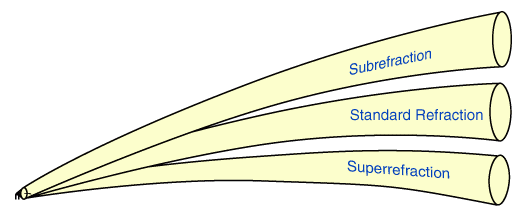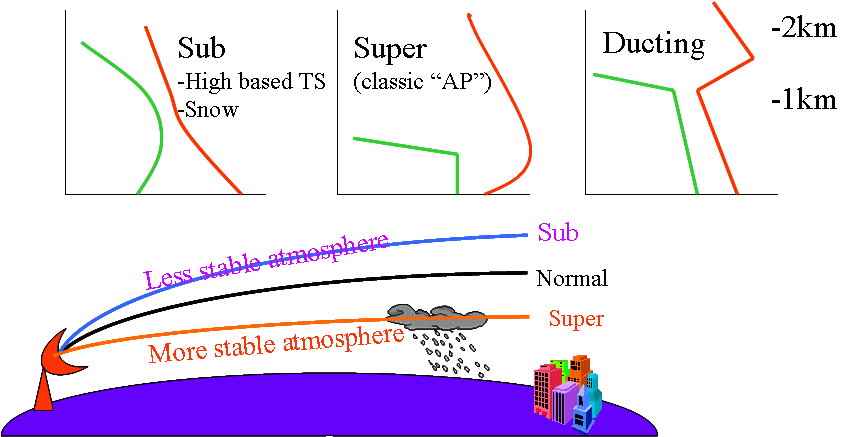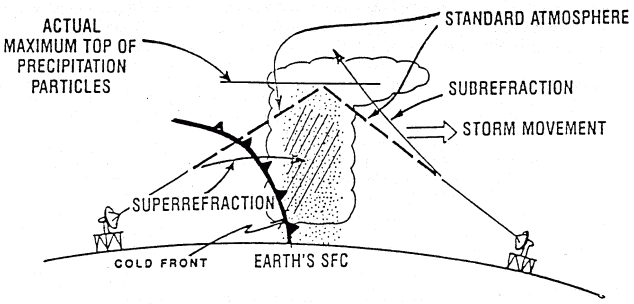Anomalous Propagation
Sub-refraction occurs when atmospheric conditions cause the radar beam
to bend less than in the Standard Atmosphere. This happens when the
atmosphere is unstable relative to the Standard Atmosphere. Sub-refraction
causes the radar to overshoot targets that would ordinarily be observed
under standard atmospheric conditions (Figure 1) and results in a
reduction in the operational range of the radar. In addition to
underestimated echo heights, this phenomenon tends to reduce ground
clutter in the lowest elevation cuts.

Figure 1. Sub- and super-refraction in comparison with standard refraction
The classic situation under which subrefraction occurs is the inverted-vee sounding, characterized by a dry-adiabatic or superadiabatic temperature lapse rate and a constant or increasing moisture supply with height. The near-surface air is typically dry. This situation is common over desert areas and on the lee side of mountain ranges, especially during the afternoon. In order to detect the tops, use of a lower elevation slice would be required, which would result in the actual tops correspondingly being displayed at a lower height than the true altitude.
Super-refraction
Super-refraction occurs when atmospheric conditions cause the radar beam to bend more than in the Standard Atmosphere (Figure 2). This happens when the atmosphere is stable relative to the Standard Atmosphere, and results in an extension in operational range. Radar coverage can be extended up to 150% of normal, especially if the super-refractive layer is surfaced-based. If the beam is not bent enough to intersect the Earth’s surface, low altitude precipitation echoes that would ordinarily be below a standard refracted beam can be detected.
Several common situations/locations under which superrefraction or beam trapping occurs are:
-
The development of a low-level temperature inversion at night associated with a sharp decrease of moisture with height.
-
A flow of warm, dry air advects over a cooler surface; this is most effective if the cooler surface is water – due to mixing, lower layers of the atmosphere are cooled and moistened.
-
The development of a sea breeze with cool moist air moving inland beneath a warm dry continental air mass.
-
Rain-cooled outflow from a thunderstorm forms a surface-based temperature inversion.
-
Location of the tropopause, which denotes an area of significant decrease of lapse rate with height.

Super-refraction results in overestimates of heights measured by radar. When super-refraction is occurring, a precipitation target is observed at a higher elevation angle than standard. The beam is closer to the ground than the standard atmosphere-based charts indicate, so the antenna must be raised to a greater elevation angle than normal to find the top of an echo.
Effects of super-refraction have a greater impact on the radar operator than do the effects of sub-refraction. Since the beam is lower than standard, low-altitude targets that would ordinarily be below the beam can be detected, as was previously stated.
Unfortunately, super-refraction can result in more range-folded echoes being detected. These echoes occur when super-refraction bends the radar beam so that it tends to follow the Earth’s curvature for long distances and targets beyond the unambiguous range of the radar are detected. The unambiguous range of a radar was discussed in the module on Radar Principles.
Another unfavourable effect of super-refraction concerns the ability of the radar to detect non-precipitation targets at extended ranges. Ground clutter, a highly reflective echo pattern typically generated from terrain features and other objects close to the radar, will be expanded under super-refractive conditions. Surface features will be detected and displayed at extended ranges when the radar beam is bent enough to travel near the ground, or bounce along the ground, for a long distance. The expanded ground clutter pattern is typically referred to as anomalous propagation (AP) by radar operators to distinguish it from precipitation echoes. The usefulness of the radar is diminished because it is often difficult to distinguish ground return from precipitation targets.
Echo properties which can be used to identify AP-induced echoes on conventional weather radars include
-
a persistent pattern for a given elevation angle, but a rapidly changing patter with change of elevation angle, and
-
a large number of small-scale features, particularly high-intensity reflectivity cores with abnormally large reflectivity gradients (greater than 20 dB change over a distance of 1 km).

Figure 3. Refraction of the radar beam with associated atmospheric conditions and consequences for the returned signal
Ducting
 Ducting is a special superrefractive condition such that the radar "beam" gets trapped or "ducted"
within a stable layer or temperature inversion. This causes the beam to
bend downward more than normal, but the beam rarely comes in contact
with the ground and little energy is lost through attenuation.
Operationally, this is an extreme case of superrefraction which can
result in the detection of targets well beyond the operating Rmax.
Ducting is a special superrefractive condition such that the radar "beam" gets trapped or "ducted"
within a stable layer or temperature inversion. This causes the beam to
bend downward more than normal, but the beam rarely comes in contact
with the ground and little energy is lost through attenuation.
Operationally, this is an extreme case of superrefraction which can
result in the detection of targets well beyond the operating Rmax.
Ducting properties:
-
Beam bends towards earth and bounces within trapping layer
-
Very large increase in effective range
-
Situations – strong inversion, with sharp decrease of moisture with height
-
Nocturnal inversion
-
Warm air flow over cool water
-
Sea breeze
-
Thunderstorm outflow
-
Tropopause
-